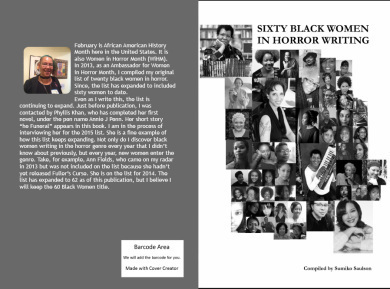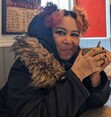Sumiko Saulson's Blog, page 41
March 2, 2014
60 Black Women in Horror now available in print
So.. this is done, I’ve got the print version of the publication on Createspace. It will roll out to Amazon and other distributors over the next 6 to 8 weeks, so for the moment it is only available here. $5.50 was the cheapest I could make it with expanded distribution. It has expanded distribution, which means it will be made available to bookstores and libraries. The reason I had to set the price this way is because it is based on the lowest profit margin distribution point: in this case, bookstores and libraries, where the profit I make is less than a dollar. It’s about a dollar on Amazon. I get more if you buy it direct from CreateSpace.
The paperback version contains the list and interviews. It doesn’t include the short stories or David Watson’s essay, which are available in the free online edition. This is because I wanted to keep the print cost down. The link is below.
https://www.createspace.com/4695298


Interview with Annie J. Penn, author of “Voodoo Knights”
 Phyllis Khan wrote the horror fantasy “Voodoo Knights” under the pen name Annie J. Penn. The story deals with black magic, monsters and aliens and features characters such as Moh Moh Oh, a manwhoring alien hybrid who is the father of all monsters, and Miss Conceptiona, a shape-shifting transgender swamp monster. She also writes short stories. Annie Penn is a nomad who lived in more than nineteen towns and cities across two continents. She is currently writing her third novel somewhere in a remote place that both man and time have forgotten. Her other must read title is No Saints also written in English. Annie Penn is bilingual and hopes to write her fourth book in her native language. When asked where home was, Annie Penn would answer, The World. She is passionate about the safety of the elderly and would like to see the citizens of the world take better care of them.
Phyllis Khan wrote the horror fantasy “Voodoo Knights” under the pen name Annie J. Penn. The story deals with black magic, monsters and aliens and features characters such as Moh Moh Oh, a manwhoring alien hybrid who is the father of all monsters, and Miss Conceptiona, a shape-shifting transgender swamp monster. She also writes short stories. Annie Penn is a nomad who lived in more than nineteen towns and cities across two continents. She is currently writing her third novel somewhere in a remote place that both man and time have forgotten. Her other must read title is No Saints also written in English. Annie Penn is bilingual and hopes to write her fourth book in her native language. When asked where home was, Annie Penn would answer, The World. She is passionate about the safety of the elderly and would like to see the citizens of the world take better care of them.
The Book: Voodoo Knights
MohMoh Oh is the spirit monster creator of the Voodooverse. Hard to believe he was once human. in his swamp lives the three headed, five legged, very moody, sometimes blood thirsty angry, but always bejewelled, bi-sexual monstrocity, the fabulous Miss Conceptiona. Very much in awe of his talents are the fierce opposition, the day time hours hospital director who becomes something totally different when day turns to night. Lets not forget the real Voodoo master, the never have been and never would be human, spirit from Planet Katanga, father the most honorable. In opposition to them all is the fast talking genius girl, Hetti O!
Annie J. Penn Interview
Q. “Voodoo Knights” combines elements of horror fiction with science-fiction genre elements such as aliens. How do you think these two genres came together in your story?
A. Voodoo Knights was my introduction to the readers. I thought if I lost them as a horror writer I could interest them with science fiction for now. I guess this has to do with my concern about being accepted as a female in horror. So, yes, merging the two genres was deliberate.
Q. What can you tell us about the sequel you are working on, about alien hybrid Moh Moh Oh, the father of all monsters?
A. I am currently multi tasking which means that Moh Moh Oh is coming along a lot slower than what I originally thought. Because he was a character in the horror-sci-fi Voodoo Knights the book continues in that vein. I am having a lot of fun with Moh Moh and would sometimes, whilst in the middle of doing something else, seek him out (stop and write about him instead).
Q. You have said regarding “Voodoo Knights,” “I now feel that I held back on the horror bits because I was unsure how the readers would take to me, a female writing horror.” Do you think that knowing that there are other women out there writing horror makes you feel more at ease about writing in the genre?
A. When I first started writing Voodoo Knights I told no one. I was worried people would find it, sorry ladies, un-ladylike. Also, I had no idea so many ladies were indeed interested in writing horror. Gee, if only I had done my research. There is no telling what Moh Moh might have been then. He might just have a surprise up his sleeve about some transformations for himself. He is after all, Moh Moh Oh the father of monster creations. Damn, I love the guy. I could talk about him all night!
Q. As I was adding you to the list of black women writing horror fiction, I realized that you are the first and so far only Australian on that list. How do you feel about representing Australia? Are you originally from there? Do you think that being Australian affects your writing or story backgrounds at all?
A. NO! I am not Australian. I come from the beautiful South Africa. I fled the Apartheid regime in 1983 and have been over here in Australia ever since. Australians are not interested in Voodoo and told me so when they rejected my manuscripts dozens of times. It is extremely difficult to write anything that is not mainstream and expect Australians to show an interest. That is me, the writer speaking. I love living in Australia.
Q. Besides “Voodoo Knights,” you write short stories. You wrote one, “The Funeral,” for the eBook edition of “60 Black Women in Horror Writing.” Is there anywhere else our readers can look for your short stories?
A. My short stories are somewhere here on my computer. I will probably publish them one day. I recently came up with the brilliant idea to publish them as a free e-book to expose myself a bit more. Gee, wonder where I got that idea from. Some of these short stories were written in Afrikaans which is the language my people speak in the Cape Province of South Africa.
Q. Is there anything else you would like the readers to know that we haven’t covered yet?
A. A couple of things about me that are not already known to my writer and reader friends: I speak English as a second language. As a matter of fact, I was about eight or nine when I was first introduced to the language in an educational facility. I am able to read and understand a third language but am unable to keep a conversation. Crazy, but true. Horror is my favourite genre, but I also write erotica and crime. I am a qualified Registered nurse but retired early due to medical reasons. I love holidaying in the United States, so much, I have been to 29 states.
Where to Find Annie Online:
http://www.amazon.com/Voodoo-Knights-Annie-Penn/dp/1470123312


March 1, 2014
Prayers and Thoughts for Greg Wilkey&His Family: RIP Alicyn
I am also very saddened by the loss of Alicyn Wilkey, a kind person, a thoughtful friend, and the wife of a good friend of mine. Eloquence escapes me at this point so I’m happier to reblog. Grief is such a personal thing. This happened very suddenly, and she was very young – she was only 42. This is a terrible tragedy. They were a very, very close couple and had been high school sweethearts before they married, they were married over twenty years.
 Originally posted on A Bibliophile's Reverie:
Originally posted on A Bibliophile's Reverie:

I’m going to keep this short. But, I wanted to relay this message to all my dear readers of this book blog. I am in so much shock, as is everyone the knew Greg Wilkey, through Anne Rice’s fantastic, loving Facebook page. Having reviewed his Mortimer Drake series here on my blog, interviewed him about his books, and talked with him at great length through Facebook, I feel that it is only appropriate to share this very, very tragic news about his wife’s passing. He is a very, very talented author, an adept wordsmith, and his wife certainly shared that same creative talent in the area of culinary arts.
Please keep Greg Wilkey and his family in your prayers, thoughts! Now, I am sharing this beautiful reading of John Donne’s “Death, Be Thou Not Proud, from the film Wit,with the poetic grace of the talented British actress: Emma Thompson. As I write Chronosphere and read through John Donne’s sermons and poems, I feel “Death, Be Thou not Proud,” whilst his shortest poem, is so achingly doleful and evocative of the ineffability of death. Everytime, I listen to this poem; I can literally hear the broken gaps in the linguistic mold of John Donne’s words, where he is trying valiantly to define death in the limited, yet strangely nonlinear space that poetry allots to the writer. I love this poem so much, and I think it’s really the best poem in the English language about death, just as Hamlet is the best Shakespeare play about death, and Frankenstein is the best novel about death.


February 28, 2014
Interview with Briana Lawrence, author of “Treat Me Kindly”
This should have been in the book 60 Black Women in Horror Fiction. In fact, it will be… so we are officially up to 62. But no, not changing the title.

 Originally posted on Sumiko Saulson:
Originally posted on Sumiko Saulson:
The Author
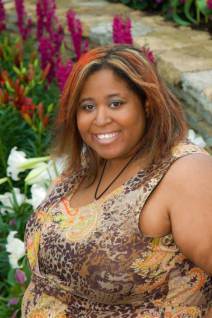 At the age of nine, like most kids, Briana Lawrence had a dream. She wanted to be the best “WRITTER” in the whole wide world. Her fourth grade class laughed and wondered how one hoped to become a “writer” if they couldn’t even spell the word. Back then her stories were created with crayons and construction paper. As she grew older they progressed into notebooks and colored ink pens of pink, blue, and purple. When she lost her older brother, Glenn Berry, in a car accident, she stopped writing.
At the age of nine, like most kids, Briana Lawrence had a dream. She wanted to be the best “WRITTER” in the whole wide world. Her fourth grade class laughed and wondered how one hoped to become a “writer” if they couldn’t even spell the word. Back then her stories were created with crayons and construction paper. As she grew older they progressed into notebooks and colored ink pens of pink, blue, and purple. When she lost her older brother, Glenn Berry, in a car accident, she stopped writing.Dreams, however, have a funny way of coming back.
Before she realized it she was grabbing her notebook and pens again. She would write stories that ranged from high school romance to her imagination running wild with the likes of Goku, Vegeta, and the other characters of Dragonball Z. This continued throughout college where she would always end up writing about the space exploits of the pilots of Gundam Wing and other works of fan fiction. Soon she realized that she wanted to do more than that. Her head was full of ideas, full of original characters and worlds that she wanted to share with others.
Thus, she stepped into an English Major with some Women’s Studies on the side.
She graduated Iowa State University in 2006 and moved to Minneapolis with her partner. Here, she tried to get into graduate school, but things didn’t pan out the way she wanted. She ended up working retail, her dream becoming buried by Black Fridays and other busy times of the year. Once again, however, that dream returned. She went from immersing herself in geeky fan fiction to actually writing about the geeky things she loved for several anime and video game review sites. However, it was her discovery of National Novel Writing Month that made her go back to creating her own characters and plots.
Now, here she is, an author in the writing world.
The Book


February 27, 2014
Anne Rice on her upcoming book reveal and women in horror

Anne Rice
As Women in Horror Month draws to a close, I am very pleased to have the opportunity to ask one of the most successful and prolific women in the genre about her upcoming book reveal, which will be taking place live on The Dinner Party Show on Sunday, March 9 at 5pm PST/8pm EST, in addition to getting her perspective on Women in Horror Month.
As Ms. Rice astutely notes, women have been a force to be reckoned with in horror from the very start.
“ I’m glad to see women honored for horror writing,” says Anne Rice. “We have always excelled in this genre. You could say the genre was created by a woman, Mary Shelley, with her stunning novel, “Frankenstein.” Not enough people have actually read the novel, in which the monster speaks for himself for pages and pages… It’s a stunner. And of course the great gothic novelists, Emily and Charlotte Bronte, have also shaped horror writing with their classics. Shirley Jackson’s horrifying story, “The Lottery” was in mid-twentieth century textbooks when I was in college. I’m glad to see women saluted for their involvement with the genre.”
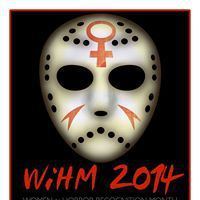 Mary Shelley is widely credited with starting the science-fiction genre and was probably the first to cross over from traditional and gothic horror into the modern horror literary genre. Released in 1818“Frankenstein” predated the works of her contemporary Edgar Allen Poe by close to a decade. Other writers who would follow in her footsteps over the next seventy years, including Bram Stoker, Oscar Wilde, and Robert Louis Stephenson. Many of the early writers of modern horror were women, as Anne points out above. Emily Bronte’s “Wuthering Heights” was a poignantly moving ghost story as well as a tale of love gone horribly awry.
Mary Shelley is widely credited with starting the science-fiction genre and was probably the first to cross over from traditional and gothic horror into the modern horror literary genre. Released in 1818“Frankenstein” predated the works of her contemporary Edgar Allen Poe by close to a decade. Other writers who would follow in her footsteps over the next seventy years, including Bram Stoker, Oscar Wilde, and Robert Louis Stephenson. Many of the early writers of modern horror were women, as Anne points out above. Emily Bronte’s “Wuthering Heights” was a poignantly moving ghost story as well as a tale of love gone horribly awry.
These women went on to influence other women, and so we have writers like Anne Rice, whose “Interview with a Vampire,” “Witching Hour,” and “Wolf Gift,” among others, carry on in the gothic horror tradition, regaling the reader with tales of supernatural and frequently deadly creatures. Like Shelley, Rice often tells the tale through the eyes of her monsters. Fans were exhilarated by her 2012 return to the genre with “The Wolf Gift,” and will be excited to know that she has a new novel in the works, currently under wraps.
Fans on her Facebook page (which has close to 1 million followers) are anxiously awaiting the announcement regarding what exactly the new book will be about. Many are wondering if we can hope to be revisited by any old friends from her literary past in the new story, and are titillated by the mystery. All will be revealed Sunday, March 9 on The Dinner Party Show, an internet radio show hosted by her son Christopher Rice and his friend, another bestselling author, Eric Shaw Quinn.
“I think the Dinner Party Show is providing me with a terrific opportunity to really talk about my new book as I reveal it,” said Rice. “I’ll be there live in the studio. I’ll be able to take questions posted on FB during the broadcast. I’ll be able to get into the whole thing. This is far better than a print announcement for me. And of course I love the show’s format, the easy exchange with Christopher and Eric, etc. So that’s why I’m very excited about revealing on the show. Since the show will air live at 5 p.m. California time, lots of people can tune in at the same time. This is infinitely more fun say than releasing a Youtube film. It’s kind of the best of the new world of technology and the old world of radio and in the flesh press conferences. “
How to Join The Online Reveal at The Dinner Party Show
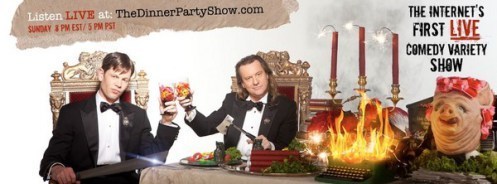
The Dinner Party Show
If you would like to be a part of the big reveal on March 9, tune in to The Dinner Party Show. You can ask Anne questions on their Facebook Page or on Twitter @DinnerPartyShow. Make sure to submit your questions on Facebook and Twitter along with the hashtag #AnneRiceReveal


Interview with Valjeanne Jeffers, Author of Immortal IV: Collision of Worlds
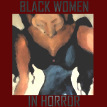 This is a part of our Black Women in Horror Interview Series. February is African American History Month here in the United States. It is also Women in Horror Month (WiHM). The Black Women in Horror interview series celebrates the place where the two intersect. These interviews are included as a part of the free eBook “60 Black Women in Horror Fiction.” The Black Women in Horror Interview Series is designed to raise the profile of and bring attention to the more than 60 black women who write horror and related genres of speculative fiction.
This is a part of our Black Women in Horror Interview Series. February is African American History Month here in the United States. It is also Women in Horror Month (WiHM). The Black Women in Horror interview series celebrates the place where the two intersect. These interviews are included as a part of the free eBook “60 Black Women in Horror Fiction.” The Black Women in Horror Interview Series is designed to raise the profile of and bring attention to the more than 60 black women who write horror and related genres of speculative fiction.
Valjeanne Jeffers Bio:
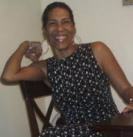
Valjeanne Jeffers
Valjeanne is the author of the SF/fantasy novels: Immortal, Immortal II: The Time of Legend, Immortal III: Stealer of Souls, and the steampunk novels: Immortal IV: Collision of Worlds and The Switch II: Clockwork (includes books 1 and 2). She is a graduate of Spelman College, NCCU and a member of the Carolina African American Writers’ Collective. She has been published under both Valjeanne Jeffers and Valjeanne Jeffers-Thompson. Her writing has appeared in: The Obamas: Portrait of America’s New First Family, from the Editors of Essence, The Ringing Ear: Black Poets Lean South, Pembroke Magazine, Revelry, Drumvoices Revue 20th Anniversary, and Liberated Muse: How I Freed My Soul Vol. I. She was also semi-finalist for the 2007 Rita Dove Poetry Award. Valjeanne’s fiction has appeared in Steamfunk!, Genesis: An Anthology of Black Science Fiction, Griots: A Sword and Soul Anthology, LuneWing, PurpleMag, Genesis Science Fiction Magazine, Pembroke Magazine, Possibilities, 31 Days of Steamy Mocha, and Griots II: Sisters of the Spear (in press). She works as an editor for Mocha Memoirs Press and is also co-owner of Q & V Affordable editing. Her two latest novels: Mona Livelong: Paranormal Detective and Colony: Ascension will be released later this year.
The Book: Immortal IV, Collision of Worlds
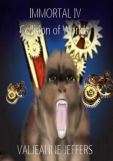 Rules were broken. Now the price must be paid.
Rules were broken. Now the price must be paid.
“The New World awoke to a roaring wind, light blazed from the mirror swallowing the planet…”
The Guardians broke the rules. As punishment, Karla and Joseph are transported to a steam powered realm. Tehotep is now ruler of the empire. Karla is his concubine. Vampires roam the streets. Androids enforce a demon’s will.
And there is no way out. Except death…
Valjeanne Jeffers Interview
Q. You write paranormal erotica, fantasy, sci-fi and steamfunk. Can you tell our readers about the steamfunk genre?
A. Steampunk first emerged as an alternate reality genre in which everything was powered by steam (and gas). For example, the 1960s Wild Wild West series (which I loved as a kid) was a steampunk TV show; although I don’t think the term had been coined yet. Wild Wild West the movie, starring Will Smith, was based upon this series.
Steampunk has given us wildly imaginative costumes, gadgets and worlds, often set in an alternate Victorian England or Western America.
But in the beginning the biggest problems with steampunk, as noticed by readers and authors, was the absence of color. Peoples of color were excluded as main characters, as were their worlds, and their challenges. So, writers and artists created steamfunk: steampunk from a Native American, Black, Latina, Asian . . . worldview; with our own heroes and heroines, in worlds we created, and taking on causes that mattered to us within an artistic space—such as oppression, equal rights, and neo-slavery— or we’re just simply telling groovy tales that came out of the Black and Brown experience. In steamfunk, folks like George Washington Carver, Harriet Tubman, and my own Simone2, become characters that tell our stories.
Authors Milton Davis and Balogun Ojetade deserve an honorable mention because they released the first steamfunk anthology, entitled simply: Steamfunk! I’m very honored to have my story, The Switch (Book I of The Switch II: Clockwork) published in this groundbreaking anthology.
Q. What do you think it is about vampires that people find so sexy?
A. Vampires are sexy, aren’t they? I think folks find them so, because they were first created as creatures who unleashed their victims’ sexuality and inhibitions. Take Bram Stoker’s character “Lucy,” for example, and Dracula’s transforming her into a vampire—which was very sexualized in Francis Ford Coppola’s remake of this classic. Of course Lucy, as all traditional victims of vampires, paid for her sexual awakening with her immortal soul.
I’m a long-time fan of vampires and, even as child, I thought they got a raw deal. Classically, every single vampire movie ended with a stake to the heart of the Nosferatu. And if you read between the proverbial lines, you see that the vampires’ greatest sin was their sexual liberation. But what’s wrong with being sexual? It’s something which should be celebrated not punished.
Others allures of the traditional vampire are that: not only do you get to live out your fantasies, the “curse” comes with meta-human speed, strength, and immortality— as well as (usually) wealth. So, the original vampires had preternatural speed, strength, and were rich. Their lives, undead though they might be, were one long, sensuous blood-drinking party. That’s the original vampire template.
Now, of course, vampires come in a myriad of varieties. Take the main character of my novel, Immortal III: Stealer of Souls, “Annabelle.” Annabelle doesn’t drink blood, she drinks time: killing her victims slowly over a period of years. Yet in keeping with the original vampire archetype, she is very sexual and an opportunist—always looking out for herself. But beneath Annabelle’s shallow, self-serving persona is a tragic history and a core of steel.
Q. More and more writers, especially women, are publishing under the speculative fiction genre category rather than the specific category of horror. Do you think that horror is a maligned genre? Do you think that people feel horror is “unladylike?”
A. I think authors are choosing to publish under the speculative fiction moniker because genres and sub-genres are tending more and more to bleed together (forgive the pun) and can’t be categorized under a single genre. For example, Charles Saunders, the creator of Sword and Soul, and a writer I greatly admire, has described my Immortal series as a world in which “science and sorcery co-exist.” Derrick Ferguson, another writer whose work I love, describes Immortal as “imaginatively experimental.” Anyone who’s read my books will tell you that they easily fit into several genres or sub-genres such as horror, science fiction, erotic and/or fantasy. I’m sure that’s true of a lot of today’s writers.
I certainly don’t feel that horror is a maligned genre, nor do I think it’s unladylike. In contrast, I think women, with each passing decade, are beginning to break out of the myths and stereotypes which have oppressed us for so long. Look at the criticism that Zora Neale Hurston endured during the Harlem Renaissance, just because she refuse to stick to the script that male writers laid out for her.
I feel that eventually terms such as “unladylike” will become a thing of the past. Female authors are constantly redefining themselves ―flexing their literary muscles if you will. So, today you’re just as likely to encounter a ghost, ghoul, bloody fight scene or sociopath in a woman’s novel as in a man’s.
Q. As you have mentioned in other interviews, science-fiction is a very white male dominated genre, and the same certainly can be said of horror―a casual search of top 10 and top 100 lists of horror writers reveals virtually no writers of color and very, very few women of any color. Do you think it is because women of color don’t write in the genre, or do you think it is due to the barriers we face when we do write?
A. Without a doubt, it’s because of the challenges we face in becoming published, whether we chose the traditional or Indie route, and then in getting exposure for our work. We face hardships as female writers. If you’re a woman of color, writing SF or horror, it’s that much harder. Oftentimes publishing houses won’t even talk to you (this was my experience) if you are a writer of color whose chooses to create characters that look, and act, like you. They don’t understand yet, that readers of all colors are looking for multicultural novels. After all, we live in multicultural world and art imitates life.
But we are here. We write. We create. We get our novels out there and our readers find us. Because they’ve been looking for us.
Q. Do you think the independent and small publishing revolution is helping to increase diversity in horror and related genres?
A. Self publishing has helped tremendously, as has the social media revolution. Both are helping writers of color get around barriers and walls that, oftentimes, were built to keep us out.
Q. One of your fans recommended you for the Black Women in Horror Writing list specifically because of your Immortal series. What can you tell our readers about the books?
A. Readers enter Immortal during the year 3075, on the planet Tundra, a utopian world that has been without racism, poverty or war for 400 years. I begin with the story with “Karla,” a young Indigo (Black) woman who works as a “healer “(drug counselor). Karla is a recovering drug addict who has gotten her life together, and used her journey to heal other addicts. But she is having disturbing dreams―some erotic; some terrifying. Two men emerge from these dreams. One of them, Joseph a Copper (Native American) man, will help unlock the mystery of her nightmares. . .and her werewolf nature.
The series continues through three more volumes: Immortal II: The Time of Legend, Immortal III: Stealer of Souls, and the concluding volume (or so I thought when I first wrote it) Immortal IV: Collision of Worlds. With each book, new characters emerge each with their own preternatural abilities. In writing the series, I drew heavily from my memories of the 1960s, one of the most beautiful and turbulent eras. And my readers tell me they get a strong “make love not war” vibe from my books.
Q. Is there an Immortal V in the works?
A. Yes, there is definitely an Immortal V in the works! Immortal IV: Collision of Worlds is actually a steamfunk novel, and one which overlaps with The Switch II: Clockwork. Both both have open-ended conclusions. Which is a hint that I’m not through with either series yet. My readers won’t stand for it, and neither will my characters.
But it will be probably one to two years before I release Immortal V. In the meantime, I’d like to invite my readers and fans to check out Mona Livelong: Paranormal Detective, a steamfunk horror novel that I’m going to release within the next few months; and Colony: Ascension An Erotic Space Opera, which will also hit the shelves later this year. There is already free ebook preview of Colony available at amazon: http://www.amazon.com/Colony-Space-Opera-Valjeanne-Jeffers-ebook/dp/B005ZWQ66K/
Q. Is there anything you would like our readers to know that we haven’t already covered?
A. I’d like to thank writer extraordinaire, Sumiko Saulson, for interviewing me and my readers and fans for their support! I’d also like to give a shout-out to my fantastic cover artist, poet Quinton Veal. Folks can preview or purchase our books at: www.vjeffersandqveal.com
Where to Find Valjeanne Online:
Her website www.vjeffersandqveal.com
Excerpts from The Immortal Series
Excerpts from her Steamfunk Series
Her two latest novels: Mona Livelong: Paranormal Detective and Colony: Ascension will be released later this year. Preview or purchase her novels at: http://www.vjeffersandqveal.com
Her Blog: http://valjeanne.wordpress.com
She has a podcast as “Crystal Temptress” (with co-host Quinton Veal as “Loyal Fang”) http://www.blogtalkradio.com/vjeffersandqveal


Interview with Eden Royce, author of Containment
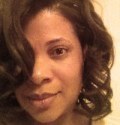
Eden Royce
Eden Royce is a native of Charleston, South Carolina whose great-aunt practiced root, a type of conjure magic. She now wishes she’d listened more closely. Her stories have been published with several presses, including Kerlak/Dark Oak Press, Sirens Call Publications, and Blood Bound Books.
She also reviews books for Hellnotes, a website dedicated to horror in fiction, art and movies and is a contributor to Graveyard Shift Sisters, a blog dedicated to purging the black female horror fan from the margins. She is also the horror submissions editor for Mocha Memoirs Press. Besides writing, she enjoys roller-skating, listening to thunderstorms, and excellent sushi.
She lurks around edenroyce.com and blogs at darkgeisha.wordpress.com
The Book: Containment
The dead are kept in chambers, their energy used to feed the City’s voracious appetite for power. This grisly fuel is watched over by Feast, a devil-human hybrid whose run-ins with the City may make him the next power source.
Eden Royce Interview
Q. You are a writer of dark fantasy and paranormal fiction. What do you consider the relationship between these genres is to horror, if any? Are they sub-genres, or simply other genres in the speculative fiction wheelhouse?
A. I believe dark fantasy goes hand-in-hand with horror. Horror is written to frighten and dark fantasy is written to fascinate and disturb. And the two overlap beautifully. I’ve written what I consider to be dark fantasy and readers have told me how creepy and scary the tale is. When creating paranormal creatures, you have to give them motivations and reasoning that is oh-so-slightly different from humans, but similar enough that we will recognize their behavior in ourselves. And that in itself is scary.
Q. Do you think women in general, and black women specifically, face in entering horror and related genres? Do you think we are still underrepresented?
A. Women that write horror are small in number compared to their male counterparts. I edited a horror and dark fantasy anthology titled “In the Bloodstream” and the majority of submissions I received were from men.
As women, we face difficulty because of perceptions: the idea that it is impossible to be a female if you write horror; that there must be something wrong with you if your mind tends toward the dark. So sometimes, we hold ourselves back on the page. Thankfully, the numbers of female horror readers are growing. Much of what appeals to women in life is safety and security: for ourselves, for children. Horror pulls against giving the reader that safety.
Black women struggle as much or more because a large portion of the Black community doesn’t read—or admit to reading—dark fiction. Society sees us as only able to write from our experience, which by the perception of many is not crafting chilling horror. There is also the religious component in many of our circles that may be disturbed at our interest in reading or writing about evil. Those concerned should strive to separate the writer from the work. Most writers of dark fiction that I’ve met are wonderful, sweet people. They just enjoy creating worlds in which the bad guy flourishes, at least for a while.
Q. In your latest novel, “Containment,” the dead are used as an energy source. There are many kinds of dead… the living dead, the Undead, spirits of the dead and corpses of the dead. What are the dead like in your story? Do they feel?
A. In “Containment”, there aren’t any zombies or vampires. (At least not at this point in the series.) So much of The City’s natural resources are gone, they have turned to spectral energy as power, similar to what supposedly creates poltergeists. There are Containment agents that stand at the bedside of the soon-to-die to capture their spirits as their physical bodies perish. There’s also a crack team of workers that track down rouge spirits that attempt escape. It’s the energy that is preserved and captured and in “Containment”, the more violent the death, the stronger the energy.
Q. Why do you think that underlying issues of mortality and life beyond the mortal realm appear so frequently in horror and dark fantasy? Do you think the genres connect with our primal fears, or need to understand these things?
A. The fear of the unknown is one of our strongest. We have solved so many mysteries in the world, but what actually happens after death always eludes us. I think it’s normal to surmise what may happen to us at the end, especially since it’s something that each one of us will have to face at some point. To me, it’s the need to influence what we have no control over. And we can do that through writing and filmmaking.
Q. Your power plant of the dead is overseen by a devil-human hybrid named “Feast.” Does his name have any special significance?
A. In the “Containment” world, all devils have one-word names, usually a verb or some sort that gives an idea of each creature’s individual power. Feast knows little about his devil side and is fascinated and a little frightened of it. I chose Feast as a name because unlike a lot of the other devil names that will be seen in Book Three, the word “Feast” has positive and negative connotations. I wanted to show through his name that there are more sides to his character than even he knows.
Q. Feast seems to be getting into a lot of trouble with The City authorities. Has he always been such a rebel? Do you think his human half is to blame?
A. I actually blame his devil side more. :Laughs: Feast is a loner and it’s usually loners that have little to lose and are willing to push the envelope. Many of the humans in “Containment” are going along with the status quo that The City sets because they have families, reputations, and lives to protect.
Feast has always been on the City’s radar as a hybrid citizen, but things happen in the story that makes Feast question the legitimacy of some of the rules. He can’t be quiet and blend into the background, because he has never had the ability to do so. (Some of his devil traits are visible.) So he does what he feels is right and that gets him in trouble.
Q. What are you working on now?
A. So many projects! I feel like I’m writing all the things. I’ve started Book Two of the Containment Series, and I’m working on my full-length novel. It’s what I call Southern Gothic horror: lots of dark places, family secrets, superstition and magic, all steeped in the culture of my hometown of Charleston, South Carolina. I got the idea from one of the stories my Grandmother told me; I hope I can do it justice.
I’ve also started the process of editing an anthology titled “Torched” for Nocturnal Press Publications. It’s my first project with and international publisher and I’m excited.
Q. Is there anything you would like our readers to know about that we haven’t already covered?
A. It is so important to support independent authors. Buy their books, or ask for them at your local bookstore or library. When you read something wonderful, leave a review or contact the author via social media. The author will appreciate your time in commenting on something that is a true part of them.
Where to Find Eden Online:
darkgeisha.wordpress.com


Author Interview with Alex Laybourne
Alex Laybourne has something new out.. “Diaries of the Damned”
 Originally posted on The Single Librarian:
Originally posted on The Single Librarian:
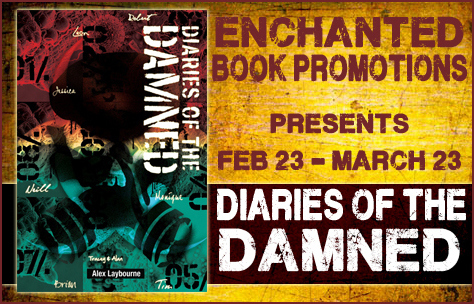
I’m interviewing Alex Laybourne, author of zombie horror “Diaries of the Damned”. Welcome to my blog, Alex, and thanks for answering my questions.
Author Interview


February 26, 2014
My [Writing] Process
I remember once, my brother told me he thought I was a very determined person. There are many compliments that a person can receive, and they are not always easy to absorb, to accept, or believe are true. This was a compliment that I believed and received with gratitude. It is true, I am determined. I am industrious. I am hard-working. I don’t give up that easily.
Time Management
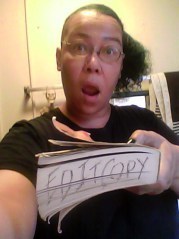 This does not change the fact that there are a limited number of hours in the day.
This does not change the fact that there are a limited number of hours in the day.
I am in the process of re-editing “60 Black Women in Horror Fiction” because the initial release was not formatted properly for the Kindle. This is a pain in the butt process that involves resizing all of the photos in Photoshop so that they are uniform, because as it turns out, cropping done in Word doesn’t translate over to the Kindle, and the photos I cropped there just blew back up to their full size, appearing in the middle of paragraphs, and making a crazy mess. Fixing this issue will take a limited amount of time: I’m already half way done. I estimate this is about eight hours worth of work, four of which I completed last night. The problem is, I have to break up my time because I have a day job, school, and family obligations
Time management is not my strong suit, so it is something I put a lot of effort into mastering because I know that it is a weakness. In order to manage my time, I break down my processes in a way that makes the most sense to me. I spent a long time in video production, and am a graduate the now defunct Film Arts Foundation’s STAND program for first time directors. I apply a lot of what I learned about how to make a short film (documentary or otherwise) to the subject of writing.
Everything is work. Writing and its related processes such as research, proofreading and editing are usually broken down in my mind into terms related to the decade or more I spent as a video editor, and those are the stages of “pre-production,” “production,” and “post production.”
Pre-production:
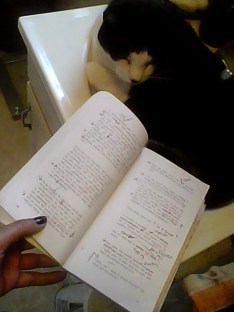 Pre-production is everything you have to do to get ready for the production of your writing product. There isn’t a great deal of pre-production involved in my writing a poem, but for a novel, there is character development. There are outlines of plot points, and there is research. This is the only part of the writing process that I habitually do on paper. My home is filled with notebooks, many of them incomplete, in which I have notes I’ve written explaining to myself how a certain character is.
Pre-production is everything you have to do to get ready for the production of your writing product. There isn’t a great deal of pre-production involved in my writing a poem, but for a novel, there is character development. There are outlines of plot points, and there is research. This is the only part of the writing process that I habitually do on paper. My home is filled with notebooks, many of them incomplete, in which I have notes I’ve written explaining to myself how a certain character is.
A clear understanding of my character’s personality types allows me to know how that particular character will react in a given situation, so that they behave consistently on a page. I approach developing characters almost the way you would approach creating a character for a role playing game of the old-fashioned board game sort.
I wasn’t a huge player of RPGs, mind you, but I have been a major ElfQuest fan since I was nineteen years old, and as a result I played the ElfQuest RPG as a board game in the late eighties and I used to roleplay ElfQuest characters in the late nineties. I stopped writing fanfic years ago because I can’t seem to stop writing horror. The very existence of Wendy Pini’s “Masque of the Red Death” makes me happy in ways I can’t begin to explain, because it is the intersection of two of two of the favorite things from my teenage life, Pini and Poe.
I approach writing characters for my novels as if I were developing a character for an RPG, and knowing the strengths, weaknesses, and personality types of those characters before I insert them into situations helps me to create a certain nexus where eventually, the book starts to practically write itself.
Production
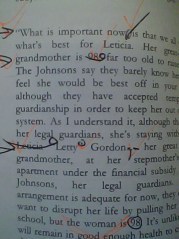 Production is where you sit around and write the thing out. In simple terms, this is the creation of the first draft of the story. It is the kind of thing that some of us do during National Novel Writing Month (NaNoWriMo). Certainly, with regards to “Disillusionment,” the sequel to “Solitude,” it is precisely what I did. I proudly wear my Camp NaNoWriMo winner’s badge on my web page and I got it for writing about 51k words of “Disillusionment.” That’s a partial first draft. It’s still not done. My novels tend to come in somewhere between 80k and 125k in word count, and I expect this one to come in around 100k.
Production is where you sit around and write the thing out. In simple terms, this is the creation of the first draft of the story. It is the kind of thing that some of us do during National Novel Writing Month (NaNoWriMo). Certainly, with regards to “Disillusionment,” the sequel to “Solitude,” it is precisely what I did. I proudly wear my Camp NaNoWriMo winner’s badge on my web page and I got it for writing about 51k words of “Disillusionment.” That’s a partial first draft. It’s still not done. My novels tend to come in somewhere between 80k and 125k in word count, and I expect this one to come in around 100k.
Writing this article is a type of production. For blogging, newspaper articles (I write for the Examiner.com), short stories and poetry, the production stage is very straightforward.
One portion of pre-production that carries over into production is research. I do as much research as I can into the worlds I create before I create them, but there will always be something I need to know that only comes to mind as I am actually writing. For example, in “Solitude,” I had to stop what I was writing and go and research the history of earthquakes in San Francisco several times, so that the ones used in the story were always actual earthquakes.
For “The Moon Cried Blood,” I had to research the cycles of the moon in 1975 so that the dates in the story matched up with the state of the moon at any given moment in the story (the full moon, the half moon, the Hunter’s Moon, the Blood Moon, the Harvest Moon).
Most of this is actually just plain old writing. I love to write, so this is both easy and enjoyable to me. I write at a good clip, and it took me three months to complete the first draft of “Solitude.” Writing is fun, and allows me to engage my emotional connection to the material and to veer away from the technical aspects of writing.
Right at the moment, I am writing this blog because it is relaxing for me, a nice diversion from the tedium that is post-production. I am often working on something new, even something small, while I am in the process of perfecting something else.
Post-Production
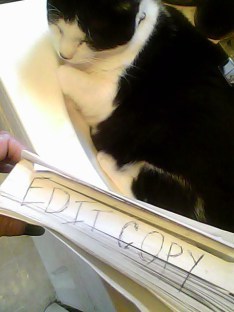 Post-Production consists of editing, proofreading, formatting, double checking facts, working with editors and beta readers, and it is the most time consuming and grueling part of the process for me. It generally takes me twice as long to get out of post as it does to actually write the danged thing, and writing something takes about twice as long as preparing to write it does, so the process of perfecting the completed work will usually take longer than the other two parts put together for all except for my very shortest pieces of writing.
Post-Production consists of editing, proofreading, formatting, double checking facts, working with editors and beta readers, and it is the most time consuming and grueling part of the process for me. It generally takes me twice as long to get out of post as it does to actually write the danged thing, and writing something takes about twice as long as preparing to write it does, so the process of perfecting the completed work will usually take longer than the other two parts put together for all except for my very shortest pieces of writing.
For short pieces of writing like flash fiction and news articles, the limitations of word count actually make the process of editing easy breezy. I used to write a lot of grants back in the day, and when you have a limited number of words in which to express yourself it becomes a sort of an art after a while, the cutting down of excess verbiage.
This is somehow much more difficult for me when I am looking at something of more than 5000 words in length. In fact, I would go so far as to say the shorter it is, the easier it is for me to polish the work. Blogging requires less spit and shine than other types of writing, and sometimes it gets stream of consciousness – like right now, as I am recalling an editor for a fashion magazine who send me a rejection letter saying she was looking for a “more polished kind of writing.” I recall my sheer glee at the number of typos in the rejection letter.
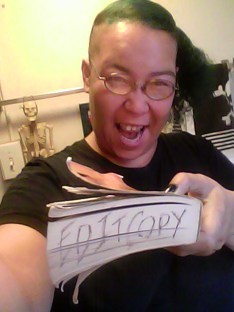 This line of thinking brings me right around the subject of typographical errors. Typos are a symptom of a limited staff: the bigger the publishing company, the more people there are pouring over your work to make sure you don’t miss anything. I know this because as a graphic designer, which is one of the two career-level day jobs I have had in my lifetime, proofreading was very often a part of my job description. I often worked for print publications, and they usually had a policy of three additional rounds of proofreading for any given layout before it hit the presses.
This line of thinking brings me right around the subject of typographical errors. Typos are a symptom of a limited staff: the bigger the publishing company, the more people there are pouring over your work to make sure you don’t miss anything. I know this because as a graphic designer, which is one of the two career-level day jobs I have had in my lifetime, proofreading was very often a part of my job description. I often worked for print publications, and they usually had a policy of three additional rounds of proofreading for any given layout before it hit the presses.
These were mostly newspapers, and the thing about print press is that you can’t just re-release the danged thing like you can with an eBook and fix any typos you missed. Those typos are there, in print, in that particular edition forever. Even if you release a new edition, it can still crop up like a bad penny.
The three rounds of proofing before it went out the door were not all the proofreading, mind you. Three times was the number of times the corrections you just made had to be proofread. There is a lot of proofreading involved in print production, and it is grueling, time consuming, and done generally by a staff of twelve or more individuals. This puts indie publishers at a disadvantage, because we are essentially going to need to drum up twelve proficient volunteers if we can’t afford to pay twelve people to go over our work.
I also find: you have to become your own proofreader, and your own editor, and no matter what else you do, you will need to go over your own work three or four times or perhaps twelve times.
It’s work. Lots and lots of hard work. It’s a drag.
Fortunately, I am very determined.


February 25, 2014
The Shadowed Sun by N K Jemisin
For WiHM… N.K. Jemisin, one of the women on the 60 Black Women in Horror list…
 Originally posted on Thinking about books:
Originally posted on Thinking about books:
[image error]book
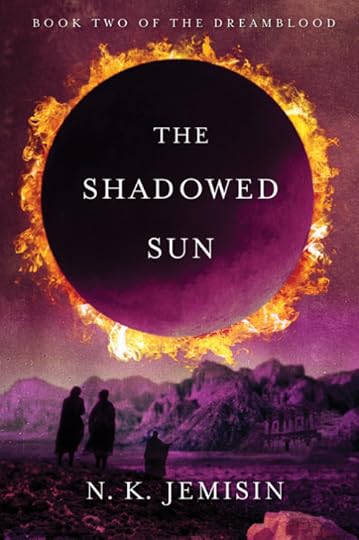
Imagine a world in which any system of magic is proven real. Magic is, by definition, the application of supernatural power with practical results in the real world. Obviously, it can take many different forms and manifest in many different ways, but each of these forms and ways is a means to access and wield power. Those with more limited abilities will only be able to influence outcomes in their immediate vicinity. Some of the top exponents will be able to produce results over wide areas. One or two may even approach god-like powers which can affect the entire world. Once the reality of the power is demonstrated, there will be people who plan to control it. In the first instance, the magicians will be bribed or intimidated into doing what they’re told. But there will always come a point when the individually powered magicians assert their own independence and decide their own fates. Quite how this works out will depend on whether the magicians feel the need to take revenge for the way they’ve been treated and whether they remain personally vulnerable.



